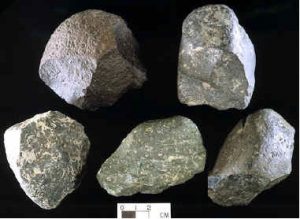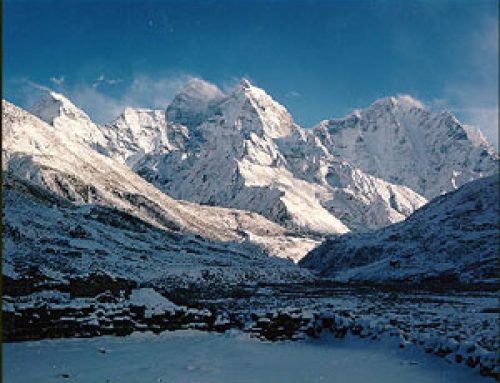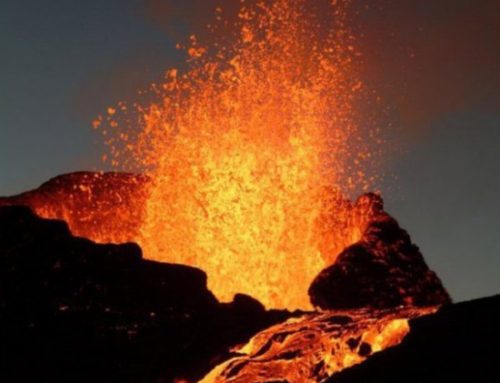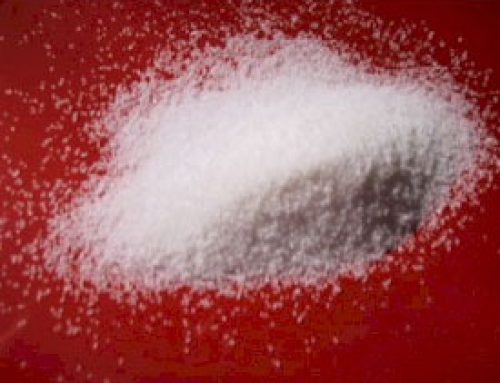Where does basalt come from?
Basalt is a fine-grained, hard rock that forms when bits of lava shoot out of volcanoes, so it’s one kind of igneous rock.
Igneous rocks
Volcanoes
All our geology articles
What is basalt made of?

Early Stone Age basalt choppers from Olduvai Gorge (Tanzania)
When the lava cools quickly, it turns into basalt. Usually basalt is black or gray. Basalt is a mixture of feldspar and pyroxene, a rock made mainly of silica and oxygen. Pyroxene is what jade is before metamorphosis.
What is feldspar?
What is jade?

Basalt grindstone (Niger, West Africa, ca. 5000 BC)
Is there basalt on other planets?
Basalt is pretty common on Earth, and there is also a lot of basalt on the Moon, and on other planets including Mars and Venus.
More about the Moon
And the other planets
Why do people want basalt?

A basalt statue of Senroset, Egyptian pharaoh
Like granite, basalt is a very hard rock. Because it is a common rock and so hard, people used basalt for early choppers and for grinding stones for grinding grains like millet and barley. Basalt makes a good stone for grinding wheat and barley and millet into flour.
History of millet
Where did barley come from?
More about granite
Basalt and long-distance trade

A Roman street paved with basalt inside Trajan’s Markets
Even in the Stone Age, people who lived in places where there was basalt were already selling basalt grindstones (along with igneous obsidian for tools) to their neighbors, and even to people living pretty far away. Basalt is heavy, but people moved it around on boats, so they didn’t have to carry it themselves.
More about obsidian
Early ships and sailing
From Sudan north to Egypt
From Sudan, donkey caravans carried basalt grindstones north to ancient Egypt. By the beginning of the Bronze Age, stone carvers in Ancient Egypt also used basalt to make statues. When you polish it, basalt makes very dramatic looking shiny black statues.
Where do donkeys come from?
Ancient Egyptian sculpture
All our Ancient Egypt articles
Basalt in the Roman Empire
In the Roman Empire, the Romans used basalt for roads, because it was very hard so it would last a long time. They still used basalt for grinding stones, too. Roman traders often shipped basalt (bu-SALT) grinding stones on sailing ships to markets all over the Mediterranean, so people could have good grinding stones even where there weren’t any volcanoes.
Roman ships and sailing
The Roman economy
All our Ancient Rome articles

A basalt grinding-mill at Ostia, near Rome

A Roman road paved in basalt (This is from Trajan’s Market in Rome)
New kinds of grindstones
In the Roman Empire, people made more complicated basalt grindstones. This one, shaped like an hourglass set over a cone-shaped piece underneath, is a typical Roman grain mill.
The basalt grain mill is in a bakery, where enslaved people poured wheat or barley in the top of the hourglass (it’s mostly broken off now), and then men or donkeys pushed the top around in circles (see the socket where you can put in a wooden beam to push with?) and the flour came out the bottom, where the little girl’s neck is. This bakery had four or five mills like this one, to make enough flour for all the bread they sold.
Slavery in ancient Rome
How do we use basalt today?

Asphalt pavement made with basalt
Today, basalt ground up and mixed with oil is a major ingredient in asphalt, and we use it to pave roads.




